Colours in the Border Collie
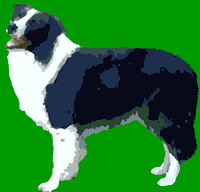
|
Colours in the Border Collie
|
|
The chart below shows how the four genes (solid colour,
tricolour, dilute and merle) inherited by an individual dog from his parents
affect the colour of a border collie's coat. |
|
KEY
|
|
| Known to be present | |
| Know not to be present | |
| Presence unconfirmed |
|
|
|||||||||||||||||||||||||
|
Black and White Border Collies
|
|||||||||||||||||||||||||
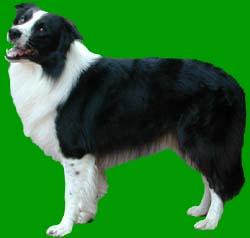 |
The colour most often encountered in the border collie and to many people the "true" border collie colour. The border collie is in fact a white dog with patches of solid, colour (sometimes diluted or broken by merle). The solid colour is referred to genetically as "spotting", the classic border collie markings are referred to as "Irish Spotting". |
||||||||||||||||||||||||
|
Black is the dominant gene for solid coat colour so a black and white dog may be masking a recessive red gene, it is not possible to tell by looking as a dog what recessive genes he carries, if he is carrying a dominant gene (shown on the left hand side) that would mask any corresponding recessive genes. | ||||||||||||||||||||||||
|
|
|||||||||||||||||||||||||
Red (brown or liver) Border Collies
|
|||||||||||||||||||||||||
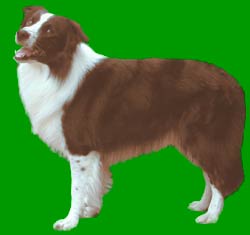 |
The red gene for solid coat colour is recessive to the black gene for solid coat colour so that in order for a dog to appear red he must carry two recessive forms of the gene for solid coat colour (i.e. red). This means that both his sire and his dam must each carry at least one copy of the red recessive gene for solid coat colour. | ||||||||||||||||||||||||
|
The colour referred to as red in the border collie is the same colour genetically as that referred to as brown or liver in some other breeds. Red is prone to bleaching in the sun. Red dogs tend to have lighter coloured eyes and liver coloured noses. | ||||||||||||||||||||||||
|
|||||||||||||||||||||||||
Blue Border Collies
|
|||||||||||||||||||||||||
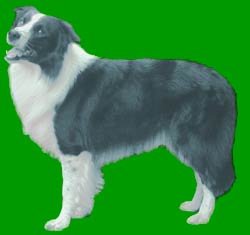 |
The blue colour is the result of the dilute gene. The two forms of the gene are no dilute (dominant) and dilute (recessive). Dilute is not a colour but acts to reduce the strength of a solid colour (either black or red) evenly across the dog's coat. This is not the same as a blue merle - the merle gene is quite different and described later. | ||||||||||||||||||||||||
|
In order to show a blue coat colour a dog must carry two recessive dilute genes - one from each of his parents so, either his parents must have been solid black or solid red and carried the dilute gene or been blue or lilac (dilute red) themselves. | ||||||||||||||||||||||||
|
|||||||||||||||||||||||||
Lilac Border Collies
|
|||||||||||||||||||||||||
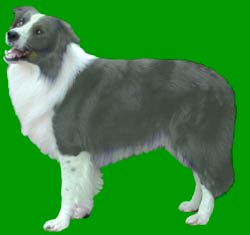 |
An uncommon coat colour, seldom seen in the canine species. Lilac is the result of the recessive red gene for solid coat colour and the recessive dilute gene for diluted coat colour acting together to create a pale red silver-grey or faun colour. This colour is most commonly seen in the Weimaraner breed although it can occur occasionally in the border collie. Lilac dogs tent to have lighter coloured eyes. Lilac is not considered to be linked to any health problems. | ||||||||||||||||||||||||
|
In order to show a lilac coat colour a dog must carry two recessive dilute genes - one from each of his parents so, his parent's must have been Black (carrying a recessive red gene) or solid red , both parents must have carried the dilute gene masked by the dominant non-dilute gene or have been blue or lilac (dilute red) themselves. | ||||||||||||||||||||||||
|
|||||||||||||||||||||||||
|
Tricolour (black white and tan) Border Collies
|
|||||||||||||||||||||||||
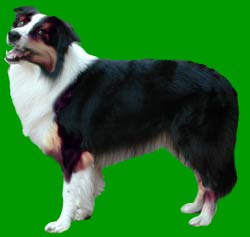 |
The tricolour markings show typically as tan spots above each eye, and around the face, the top of the front and lower coloured part of the back legs. With the tricolour gene, no tri or "tri switched off" is the dominant form so that dogs showing tricolour characteristics must carry two recessive tri (tri switched on) genes. Tri varies in its intensity and coverage, some dogs develop the full extent of their tricolour pattern only later in life, this can lead to confusion if a tricolour is not recognised as such before it is registered and its colour recorded. Tricolour pups are easy to recognise by a distinct patch of tan under their tail. | ||||||||||||||||||||||||
|
This dog has one dominant black gene for solid coat colour (other gene for solid coat colour unknown, either black or red) and two recessive genes for tricolour switched on, hence the tricolour markings. All tricolours show some pale hairs around the anus. | ||||||||||||||||||||||||
|
|
|||||||||||||||||||||||||
|
Blue Tricolour Border Collies
|
|||||||||||||||||||||||||
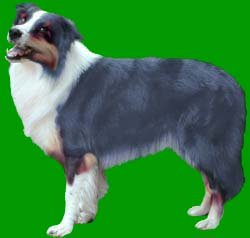 |
Because the coat colour of the border collie is determined by a number of genes all independent of each other several "colours" may manifest themselves in one dog. Here the dog is basically a black and white who also carries two recessive genes for dilute and two recessive genes for tri colour (tan). He might carry one gene for solid red - we cannot tell. | ||||||||||||||||||||||||
|
In the case of this dog we know he has two recessive dilute genes (or he could not show dilute (blue or lilac) and two dilute genes for tri (or he would not show tan) , we also know that he does not carry merle (as merle is a dominant gene it would show). | ||||||||||||||||||||||||
|
|
|||||||||||||||||||||||||
|
Red Tricolour Border Collies
|
|||||||||||||||||||||||||
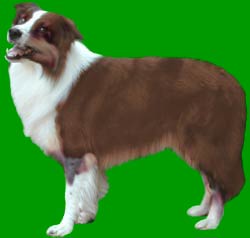 |
Here the dog is a red and white so he must carry two recessive genes for solid coat colour (black is dominant, red is recessive) and two recessive genes for tri colour (tan pionts). As with the blue tricolour, the black and white and the red and white, we know that this dog does not carry merle. If merle is present it will show because it is dominant. | ||||||||||||||||||||||||
|
What we cannot tell by looking at this dog whether or not he carries the dilute gene. He does not carry two dilute genes (or he would be a lilac tri) because he has a solid coat colour (red) but he could carry one dilute gene and one no dilute gene, the no dilute being dominant . | ||||||||||||||||||||||||
|
|
|||||||||||||||||||||||||
|
Blue Merle Border Collies
|
|||||||||||||||||||||||||
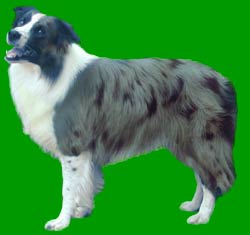 |
Merle is an interesting gene found in many breeds of dog including shelties and rough collies, but it is often referred to by different names (dappled in dachshunds, harlequin in great Danes, tweed in australian shepherds, etc.). The merle gene is dominant so that if a dog carries just one merle gene he will display merle characteristics. Merle is a "semi Lethal" gene, provided one parent does not carry the Merle gene it would be expected that puppies will be of normal development and health. However if two Merles are mated any resulting pups with two copies of the dominant Merle gene may suffer deformaties such as missing eyes or they be blind or deaf. | ||||||||||||||||||||||||
|
Merle acts to break up the solid colour of the dog's coat (either black or red) with a patchwork of white and irregular spots or patches of black or red depending upon whether the dog carries the dominant black or recessive red gene for solid coat colour. |
||||||||||||||||||||||||
|
|
|||||||||||||||||||||||||
|
Red Merle Border Collies
|
|||||||||||||||||||||||||
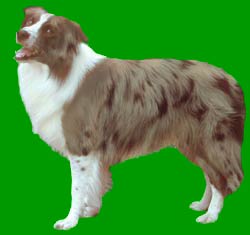 |
Because merle is dominant it might be expected that it would be very common, but this is not the case. Merle is what is known as a semi-lethal gene and for this reason a merle should not be mated to another merle, If two merles are mated together those puppies which receive two merle genes (one from each parent) are may suffer severe health problems. | ||||||||||||||||||||||||
|
Puppies which carry two merle genes are likely to have a completely or almost completely white coat, be blind, have abnormally small or even no eyes and could be partially or completely deaf. So merles should always be mated to a solid colour (whether dilute or not). | ||||||||||||||||||||||||
|
|
|||||||||||||||||||||||||
|
Blue Merle and Tri Border Collies
|
|||||||||||||||||||||||||
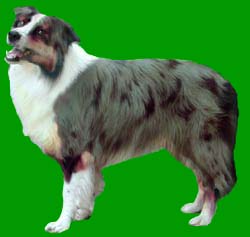 |
Merle is one of the few dominant genes where it is possible to determine that the dog also carries a recessive gene (for no merle) because of the absence of the perponderance of white and the lack of health problems described above. Merles frequently produce blue or partially blue eyes. Completely blue eyes are sometimes called "China" or "Wall" eyes. and have no visual impairment associated with them. | ||||||||||||||||||||||||
|
The most usual form of merle is Blue Merle, here the dog carries the dominant black gene for solid coat colour which is turned to a marbled blue by the dominant merle gene. If the dog also carries two recessive genes for tri he will show the tri colour as well as the blue merle. | ||||||||||||||||||||||||
|
|
|||||||||||||||||||||||||
|
Red Merle and Tri Border Collies
|
|||||||||||||||||||||||||
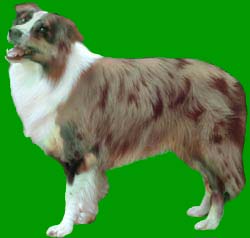 |
As might be expected the red merle colour is less common because red is a recessive gene. Here the dog carries two recessive genes for the solid red coat colour and two recessive genes for the tri markings, in addition the dog carries one dominant gene for merle (hence the coat is marbled with white) and one recessive gene for no merle. This will not per se cause any health problems. | ||||||||||||||||||||||||
|
Dilute blue or lilac merles are uncommon due to the recessive nature of the dilute gene and the relatively less popular, dominant merle gene. Although these colours will ineviabley occur from time to time most breeders would avoid such colour combinations concentrating on temperament, type and quality rather than novelty value. | ||||||||||||||||||||||||
|
|
|||||||||||||||||||||||||
|
White Border Collies
|
|||||||||||||||||||||||||
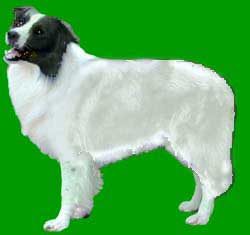 |
Not a colour, but an absence of colour. So called white border collies simply lack the "spotting" or colour from most of areas of their coat. Few border collies are completely white but have limited areas of colour usually on their head, particularly around the eyes. A "white" border collie may carry any of the colours described above but white will predominate. | ||||||||||||||||||||||||
| White border collies have always been unpopular in the herding world and show ring, the standard states that white should not predominate. Although no proof exists that white border collies are less healthy or poorer workers than well coloured specimens it is probably unwise to mate predominately white border collies to other predominately white border collies. | |||||||||||||||||||||||||
| In addition to the colours above other colours appear in border collies from time to time. Sable and shaded sable are less frequently encountered colours but certainly do exist in the pure bred border collid. Other colours such as brindle are amost certainly the result of cross breeding and some colours such as "yellow" or "golden" (sometimes called Aussie Red) are sometimes seen abroad - these probably inherited from other local breeds. The standard for the breed states that a variety of colours are permissible but that white should never predominate. |
Alice |
|||||
Pedigrees |
|
material on this site is copyright
mastamariner© do not take or copy without permission |